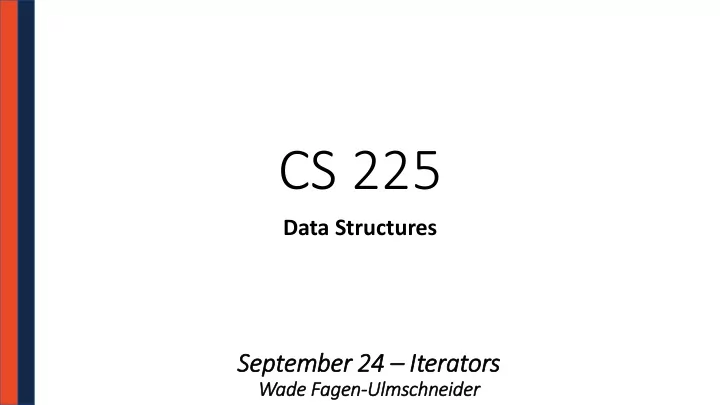

CS 225 Data Structures September 24 – It Iterators Wade Fagen-Ulm lmschneid ider
CS 225 So Far… List ADT • Linked Memory Implementation (“Linked List”) • O(1) insert/remove at front/back • O(1) insert/remove after a given element • O(n) lookup by index • Array Implementation (“Array List”) • O(1) insert/remove at front/back • O(n) insert/remove at any other location • O(1) lookup by index
CS 225 So Far… Queue ADT • [Order]: • [Implementation]: • [Runtime]:
CS 225 So Far… Stack ADT • [Order]: • [Implementation]: • [Runtime]:
Queue.h #pragma once What type of implementation is this Queue? 1 2 3 template <typename T> 4 class Queue { 5 public: 6 void enqueue(T e); 7 T dequeue(); 8 bool isEmpty(); How is the data stored on this Queue? 9 10 private: 11 T *items_; 12 unsigned capacity_; 13 unsigned count_; 14 }; 15 16 17 18 19 20 21 22
Queue.h #pragma once What type of implementation is this Queue? 1 2 3 template <typename T> 4 class Queue { 5 public: How is the data stored on this Queue? 6 void enqueue(T e); 7 T dequeue(); Queue<int> q; 8 bool isEmpty(); q.enqueue(3); 9 q.enqueue(8); 10 private: q.enqueue(4); 11 T *items_; q.dequeue(); 12 unsigned capacity_; q.enqueue(7); 13 unsigned count_; q.dequeue(); 14 }; q.dequeue(); 15 16 q.enqueue(2); 17 q.enqueue(1); 18 q.enqueue(3); 19 q.enqueue(5); 20 q.dequeue(); 21 q.enqueue(9); 22
Queue.h Queue<char> q; #pragma once 1 q.enqueue(m); 2 3 template <typename T> m o n q.enqueue(o); 4 class Queue { q.enqueue(n); 5 public: … 6 void enqueue(T e); q.enqueue(d); 7 T dequeue(); q.enqueue(a); 8 bool isEmpty(); q.enqueue(y); 9 q.enqueue(i); 10 private: q.enqueue(s); 11 T *items_; q.dequeue(); 12 unsigned capacity_; 13 unsigned count_; q.enqueue(h); 14 }; q.enqueue(a); 15 16 17 18 19 20 21 22
Im Implications of f Design 1. class ListNode { public: T & data; ListNode * next; … 2. class ListNode { public: T * data ; … 3. class ListNode { public: T data; …
Im Implications of f Design Storage by Reference Storage by Pointer Storage by Value Who manages the lifecycle of the data? Is it possible for the data structure to store NULL? If the data is manipulated by user code while in our data structure, is the change reflected in our data structure? Speed
Data Lifecycle Storage by reference: 1 Cube c; 2 myStack.push(c); Storage by pointer: 1 Cube c; 2 myStack.push(&c); Storage by value: 1 Cube c; 2 myStack.push(c);
Possible to store NULL? Storage by reference: class ListNode { public: T & data; ListNode * next; ListNode(T & data) : data(data), next(NULL) { } }; Storage by pointer: T ** arr; Storage by value: T * arr;
Data Modifications 1 Cube c(1); 2 myStack.push(c); 3 4 c.setLength(42); 5 6 Cube r = myStack.pop(); 7 // What is r's length?
Speed
It Iterators Suppose we want to look through every element in our data structure: Ø 8 2 5
Iterators encapsulated access to our data: Cur. Location Cur. Data Next Ø 8 2 5
It Iterators Every class that implements an iterator has two pieces: 1. [Implementing Class]:
It Iterators Every class that implements an iterator has two pieces: 2. [Implementing Class’ Iterator]: • Must have the base class std::iterator • Must implement operator* operator++ operator!=
stlList.cpp #include <list> 1 2 #include <string> 3 #include <iostream> 4 5 struct Animal { 6 std::string name, food; 7 bool big; 8 Animal(std::string name = "blob", std::string food = "you", bool big = true) : 9 name(name), food(food), big(big) { /* nothing */ } 10 }; 11 12 int main() { 13 Animal g("giraffe", "leaves", true), p("penguin", "fish", false), b("bear"); 14 std::vector<Animal> zoo; 15 16 zoo.push_back(g); 17 zoo.push_back(p); // std ::vector’s insertAtEnd 18 zoo.push_back(b); 19 20 for ( std::vector<Animal>::iterator it = zoo.begin(); it != zoo.end(); it++ ) { 21 std::cout << (*it).name << " " << (*it).food << std::endl; 22 } 23 24 return 0; 25 }
stlList.cpp #include <list> 1 2 #include <string> 3 #include <iostream> 4 5 struct Animal { 6 std::string name, food; 7 bool big; 8 Animal(std::string name = "blob", std::string food = "you", bool big = true) : 9 name(name), food(food), big(big) { /* none */ } 10 }; 11 12 int main() { 13 Animal g("giraffe", "leaves", true), p("penguin", "fish", false), b("bear"); 14 std::vector<Animal> zoo; 15 16 zoo.push_back(g); 17 zoo.push_back(p); // std ::vector’s insertAtEnd 18 zoo.push_back(b); 19 20 for ( const Animal & animal : zoo ) { 21 std::cout << animal.name << " " << animal.food << std::endl; 22 } 23 24 return 0; 25 }
Recommend
More recommend